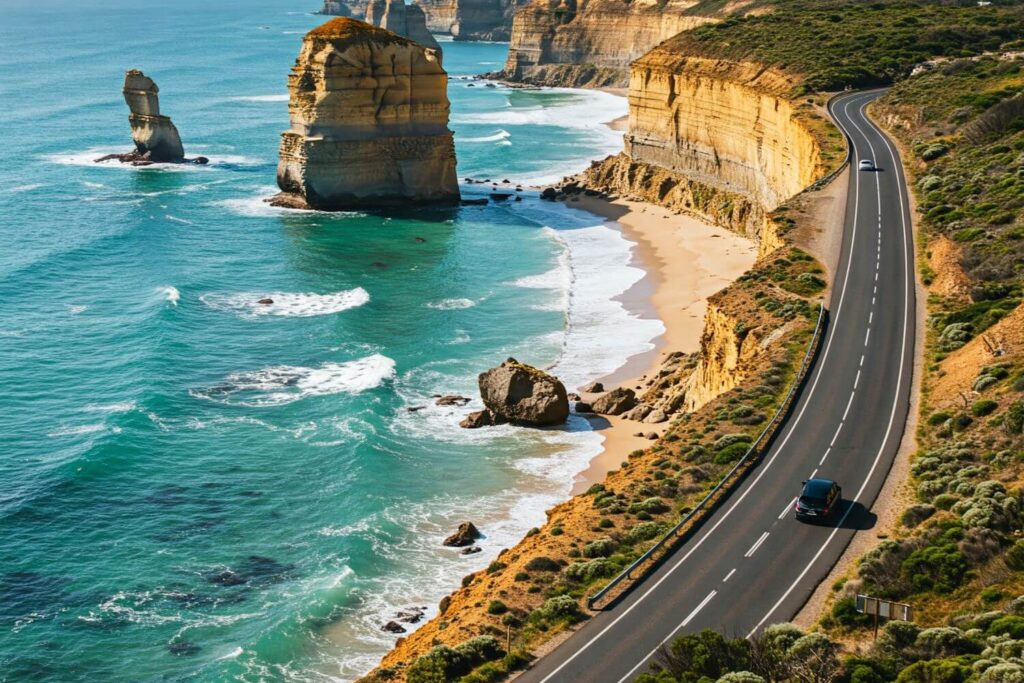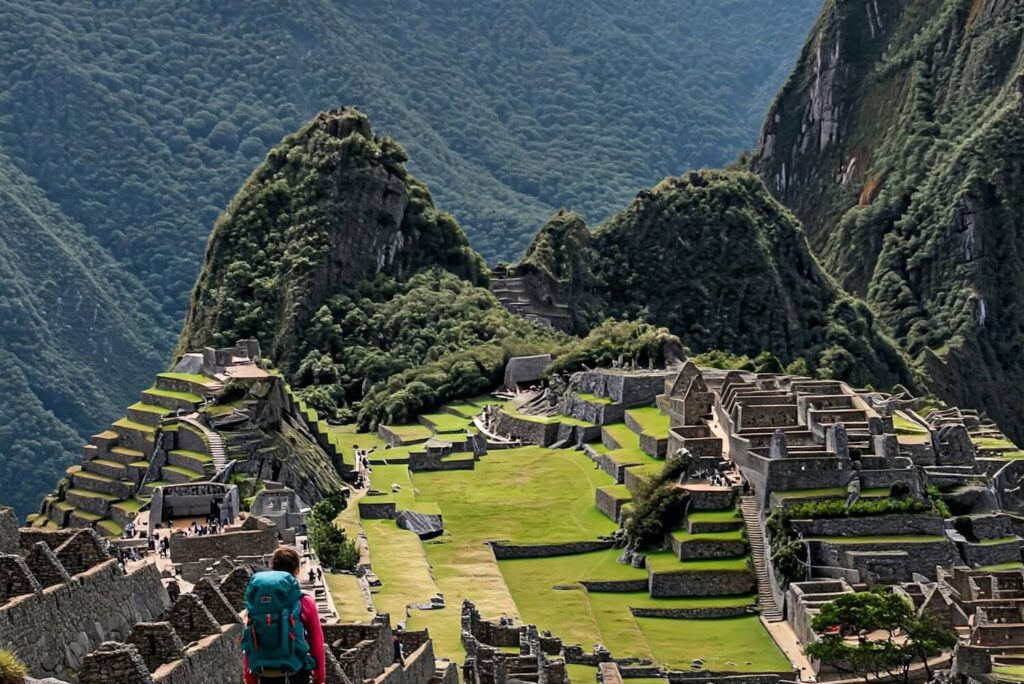Introduction to the Great Ocean Road
The Great Ocean Road is one of Australia’s most iconic scenic drives, spanning approximately 243 kilometers along the country’s picturesque south-eastern coastline. This remarkable feat of engineering was originally constructed between 1919 and 1932 by returned soldiers as a memorial to their fallen comrades during World War I. The road, winding through breathtaking landscapes, was established with both practical and commemorative intentions, connecting several coastal towns while simultaneously allowing locals and tourists to appreciate the area’s natural beauty.
Geographically, the Great Ocean Road stretches from the surf town of Torquay to the coastal community of Allansford, nestled near the city of Warrnambool. It passes through an array of stunning vistas, including rugged cliffs, pristine beaches, and rich rainforests, creating a captivating experience for those who travel its length. The route is particularly famed for its dramatic rock formations, such as the Twelve Apostles, a collection of limestone stacks that rise majestically from the Southern Ocean, attracting visitors from around the globe.
In addition to its stunning landscapes, the Great Ocean Road serves as a vital hub for tourism in Australia, welcoming over 12 million visitors each year. Travelers flock to this coastal drive not only for its scenic views but also for a myriad of recreational activities, including surfing, hiking, wildlife watching, and exploring charming seaside towns. The allure of the Great Ocean Road extends beyond its aesthetic appeal; it symbolizes a connection to Australia’s history and culture, making it an essential itinerary component for those exploring the region.
Overall, the Great Ocean Road represents a unique blend of natural beauty, historical significance, and cultural relevance, affirming its place as a must-visit destination for both domestic and international travelers.
History and Construction
The Great Ocean Road, renowned as one of Australia’s most picturesque coastal routes, holds a storied history that dates back to its construction in the aftermath of World War I. The idea of connecting the coastal towns of Victoria with a scenic roadway emerged as a means to provide return employment to soldiers who had served in the war. The project was not just a matter of constructing a road; it was a significant post-war initiative that aimed to boost local economies by improving accessibility and fostering tourism.
Construction of the Great Ocean Road commenced in 1919 and was spearheaded by the Returned Soldiers’ Association of Victoria. It served as both a challenging engineering endeavor and a symbol of national pride for returning veterans. The road stretches for approximately 243 kilometers along the rugged south-eastern coast of Australia, offering breathtaking views of the ocean and lush landscapes. The scale of the project posed numerous difficulties, including harsh weather conditions, unstable terrain, and the need to incorporate environmentally sustainable practices into its design.
Laborers faced considerable challenges in the construction of the Great Ocean Road, as they were often tasked with carving the roadway into steep cliffs and dense forests. Utilizing hand tools and basic machinery, these laborers worked tirelessly, demonstrating remarkable resilience and ingenuity. The materials used in the construction predominantly comprised local rock and gravel, which not only provided structural strength but also helped the road blend seamlessly with the surrounding environment. This thoughtful approach to construction ensured that the road would endure the test of time, while establishing a vital connection for local communities.
Ultimately, the Great Ocean Road’s completion in 1932 marked a monumental achievement, highlighting its importance not only as a transportation route but also as a vital economic lifeline for the region. Today, it stands as a testament to human perseverance and vision, offering travelers an unforgettable journey along one of the world’s most stunning coastlines.
Must-See Attractions Along the Route
The Great Ocean Road is renowned for its breathtaking scenery and a plethora of attractions that captivate visitors from around the globe. Among the most iconic sites is the Twelve Apostles, a series of impressive limestone stacks that rise dramatically from the Southern Ocean. This natural wonder provides a stunning backdrop for photography and offers well-maintained viewing platforms. Visitors can also enjoy guided tours that offer insights into the geological history and significance of these formations, making it a must-visit spot for anyone traversing this scenic drive.
Another highlight along the Great Ocean Road is the London Arch, formerly known as London Bridge. This natural rock formation has a fascinating history, notably its partial collapse in 1990, which resulted in its current name. London Arch offers a picturesque viewpoint where travelers can take in the stunning coastal scenery and observe marine wildlife, such as dolphins and seals. Travelers are encouraged to visit during sunrise or sunset when the lighting creates a magical ambiance, making the experience even more unforgettable.
For those seeking a lush escape from the coastal views, the Otway Rainforest is an exceptional destination. This vibrant ecosystem is home to towering trees, rich wildlife, and a range of walking trails suitable for all fitness levels. The tree-top walk provides an exhilarating experience as visitors can stroll among the canopy, gaining a unique vantage point of the forest floor below. Additionally, the rainforests offer various guided tours and educational programs that highlight the importance of conservation and the rich biodiversity of the region.
Each of these attractions presents unique opportunities for exploration and engagement with Australia’s natural beauty, making them essential stops along the Great Ocean Road. Visitors are encouraged to plan their itineraries to ensure they experience these remarkable sites firsthand, enhancing their journey through this picturesque region.
The Natural Beauty of the Coastline
The Great Ocean Road is renowned for its stunning natural beauty, showcasing a diverse array of landscapes that captivate visitors at every turn. As drivers embark on this scenic coastal drive, they are greeted with breathtaking vistas that range from rugged cliffs and sandy beaches to verdant rainforests. Each segment of the journey reveals a world of unique ecosystems, with distinct flora and fauna that thrive in this picturesque setting.
One of the most iconic features along the route is the dramatic coastline shaped by the relentless powers of the Southern Ocean. The Twelve Apostles, towering limestone stacks that rise majestically from the sea, epitomize the grandeur of this coastline, drawing countless tourists. This remarkable formation stands as a testament to the natural forces at work, illustrating how erosion and weathering sculpted the landscapes into awe-inspiring formations. Visitors are often left speechless as they witness the hues of the cliffs change with the rising and setting sun.
While the cliffs and rock formations are certainly a highlight, the Great Ocean Road is also home to pristine beaches that beckon adventurers and relaxation seekers alike. The beaches offer opportunities for swimming, surfing, and exploring the shorelines, where one can often spot a variety of marine wildlife, including dolphins and seals. Moreover, the hidden coves and sandy stretches present perfect spots for quiet contemplation or leisurely picnics amidst nature.
Inland, the lush rainforests provide a remarkable contrast to the coastal scenery, showcasing Australia’s rich biodiversity. With abundant wildlife, including koalas, kangaroos, and myriad bird species, these forests invite exploration and discovery. Walking trails wind through towering trees and ferns, enabling visitors to immerse themselves in the tranquility of nature, all while highlighting the remarkable ecosystems that thrive along the Great Ocean Road.
Outdoor Activities and Adventures
The Great Ocean Road is not only celebrated for its picturesque scenery but also for the plethora of outdoor activities it offers. For those keen on embracing the vibrant natural landscape, options abound, making it an ideal destination for adventure seekers. Surfing, hiking, and wildlife tours are among the top attractions that allow visitors to immerse themselves in the region’s stunning environment.
Surfing enthusiasts can take advantage of the excellent waves found in locations such as Bells Beach and Lorne. These beaches are recognized for their consistent swells, catering to both beginners and experienced surfers. For newcomers, surf schools provide essential lessons and equipment rental, ensuring a safe and enjoyable experience on the water. Always check local conditions and surf reports before heading out, and remember that wearing a wetsuit is advisable for comfort and safety.
Hiking trails along the Great Ocean Road offer breathtaking views and diverse terrains, suitable for different fitness levels. Notable trails include the Great Ocean Walk, which stretches 104 kilometers and showcases stunning coastal vistas, lush rainforests, and picturesque waterfalls. For day hikes, the short trails in Otway National Park are highly recommended, where visitors can engage with the unique flora and fauna. Proper footwear and plenty of water are essential, along with a good map to ensure a safe journey through this captivating wilderness.
Wildlife tours are another must-do activity for nature lovers, providing opportunities to witness local species in their natural habitats. Popular spots for viewing wildlife include the Great Otway National Park and Tower Hill Wildlife Reserve. Engaging with a guided tour ensures that you gain insight into the region’s unique ecosystems and enhances the overall experience. Keep your camera ready, but remember to respect the wildlife and adhere to safety guidelines when observing these magnificent creatures in the wild.
Culinary and Cultural Experiences
The Great Ocean Road is not only a feast for the eyes, but it also offers an array of culinary delights and cultural experiences that enhance the journey along this iconic coastal drive. Each town along the route boasts its unique flavor, showcasing local produce, traditional recipes, and innovative cuisine. From the quaint village of Apollo Bay to the vibrant town of Lorne, food enthusiasts will discover an abundance of eateries emphasizing fresh seafood caught from the nearby waters, artisanal cheeses, and gourmet coffee.
One of the highlights is the Apollo Bay Market, held on Saturdays, where local producers and artisans gather to sell their goods. Here, visitors can sample everything from handmade chocolates to organic fruits and vegetables. This market not only supports local farmers and businesses but also provides insight into the region’s agricultural heritage, making it an essential stop for anyone interested in experiencing the authentic flavors of the area.
Cultural attractions abound along the Great Ocean Road, with various art galleries and exhibitions showcasing the works of local artists inspired by the stunning landscape. The Art Gallery of Ballarat, located just a short detour from the coast, houses an extensive collection of Australian art, while smaller galleries along the way often feature rotating exhibitions that highlight the talents of emerging artists. Festivals also play a crucial role in celebrating the cultural diversity of the region. Events such as the Lorne Festival of Performing Arts and the Great Ocean Road International Film Festival draw both locals and tourists, offering performances and screenings that reflect the creative spirit of the local community.
In conclusion, the culinary and cultural experiences along the Great Ocean Road serve as a testament to the area’s rich heritage and vibrant community. These attractions not only enhance the journey but also provide visitors with a deeper understanding of Australia’s coastal culture.
Planning Your Trip: Tips and Recommendations
Embarking on a journey along the Great Ocean Road is an exciting endeavor. As one of Australia’s most iconic coastal drives, planning your trip effectively can enhance your experience of this stunning location. Firstly, the best time to visit is during the Australian spring (September to November) or autumn (March to May). During these seasons, the weather is generally mild, offering ideal conditions for photography and outdoor activities while avoiding the crowds of peak summer.
When considering an itinerary, a popular suggestion is to allocate at least two days for the drive. This allows ample time to explore key attractions such as the Twelve Apostles, Loch Ard Gorge, and the picturesque coastal towns of Lorne and Apollo Bay. A recommended route would start in Torquay, with an overnight stay in either Apollo Bay or Port Campbell for a more leisurely experience. Each destination boasts unique attractions, ensuring travelers can fully appreciate the scenic beauty and cultural richness of the region.
Accommodation options are plentiful, ranging from luxury hotels and boutique stays to campgrounds for those wishing to be closer to nature. It is advisable to book ahead, especially during peak tourist seasons, to secure the best options available. Additionally, essential items such as a reliable GPS or map, water, snacks, and a camera to capture the breathtaking vistas are crucial for a successful trip.
Regarding road conditions, the Great Ocean Road is well-maintained, although some sections are narrow and winding. Drivers should maintain vigilance and adhere to speed limits, especially around bends and coastal viewpoints. It is also important to check weather conditions, as heavy rainfall can affect driving safety. Fuel stations are available, but fill up regularly to avoid running low in more remote areas. Such preparation ensures a safe and memorable adventure along this remarkable coastline.
Environmental Considerations and Conservation Efforts
The Great Ocean Road is not only a stunning showcase of Australia’s diverse coastal landscapes but also a region that faces significant environmental challenges. As tourism continues to grow in popularity, the pressure on local ecosystems increases, making it essential to implement conservation strategies aimed at preserving the natural beauty and biodiversity of the area. Preserving habitats, safeguarding marine life, and reducing pollution are critical components in the regional conservation efforts.
Various organizations and local governments have initiated programs to protect the unique flora and fauna found along the Great Ocean Road. For instance, initiatives focused on reforestation and habitat restoration are vital for maintaining the health of ecosystems impacted by tourism. Additionally, invasive species management has become a priority, as non-native plant and animal species can disrupt the balance of the native environment, threatening the survival of indigenous species.
Travelers can play an essential role in these conservation efforts by adopting eco-friendly practices during their visits. Simple actions such as sticking to marked trails, avoiding littering, and being mindful of wildlife can significantly reduce human impact on sensitive habitats. Furthermore, visitors are encouraged to participate in local conservation programs that may involve beach clean-ups, tree planting, or educational workshops aimed at raising awareness about environmental stewardship.
Promoting sustainable tourism is crucial for the future of the Great Ocean Road. This not only involves individual responsibility but also encourages businesses to adopt greener practices, such as utilizing renewable energy sources or providing eco-friendly accommodations. By supporting these initiatives, travelers can enjoy the breathtaking scenery while contributing to the preservation of this iconic coastal drive for generations to come.
Conclusion: The Unforgettable Experience of the Great Ocean Road
The Great Ocean Road, an iconic journey along Australia’s southern coastline, offers travelers an unparalleled experience filled with breathtaking landscapes and unique attractions. Spanning over 240 kilometers, this scenic drive showcases the diverse beauty of the Australian coast and provides opportunities to explore charming towns, serene beaches, and stunning natural formations, such as the Twelve Apostles. Each turn along the winding road unveils a new picturesque vista, emphasizing the road’s reputation as one of the world’s most scenic coastal drives.
This magnificent route also holds historical significance, having been built as a memorial to those who served in World War I. Today, it stands as a tribute to their sacrifices while simultaneously inviting visitors to immerse themselves in nature’s splendor. The Great Ocean Road is not merely a drive but an adventure that embodies the rich cultural and natural heritage of Australia. From the lush rainforests of the Otway National Park to the rugged cliffs descending into the Southern Ocean, each segment of the journey tells a story that resonates with both locals and tourists alike.
As travelers endeavor to experience the Great Ocean Road, they are encouraged to take their time. Stopping at various lookout points, indulging in local cuisine, and engaging with the vibrant communities along the route enhances the overall travel experience. Observing the ever-changing interplay of light on the ocean during sunrise or sunset can be particularly mesmerizing, leaving a lasting imprint on the memory of all who visit.
For those seeking an unforgettable adventure rich in natural wonders and cultural experiences, the Great Ocean Road undeniably deserves a place on their travel itinerary. Exploring this scenic coastal drive allows for the creation of cherished memories that will last a lifetime, making it an essential journey for anyone venturing to Australia.



